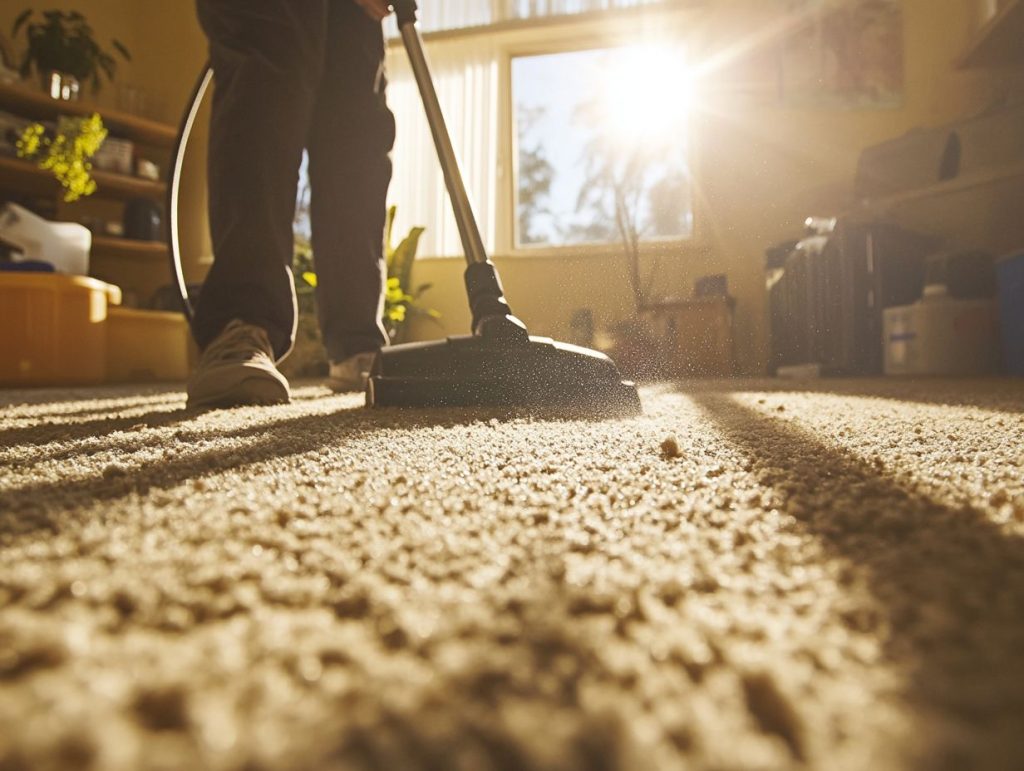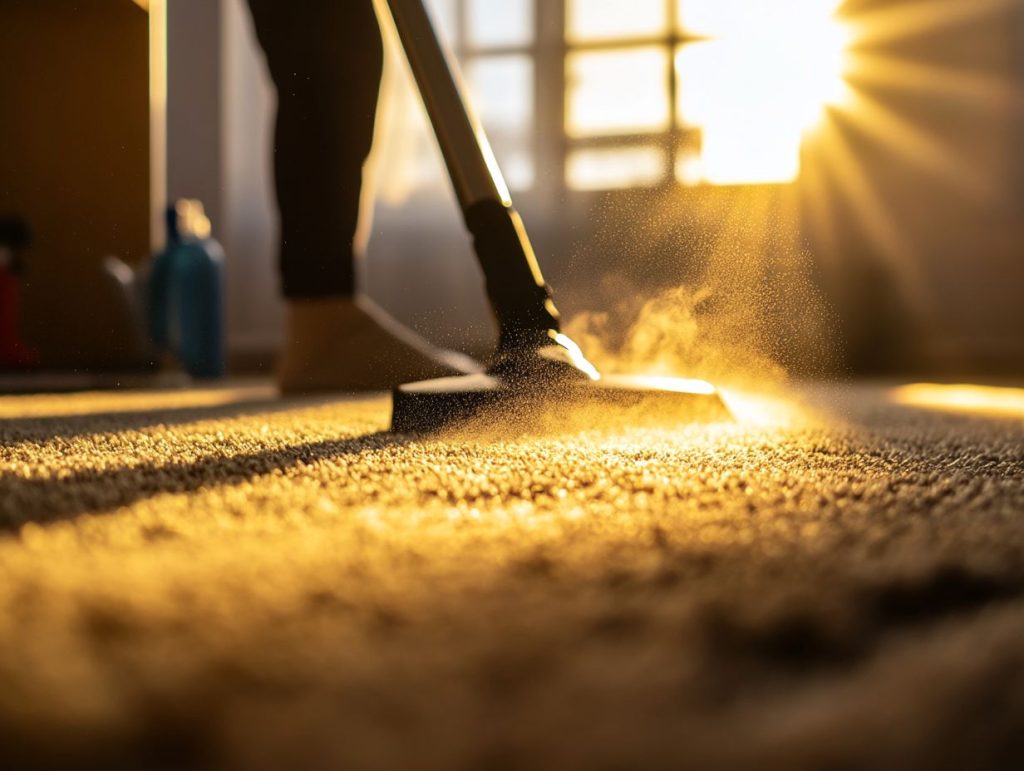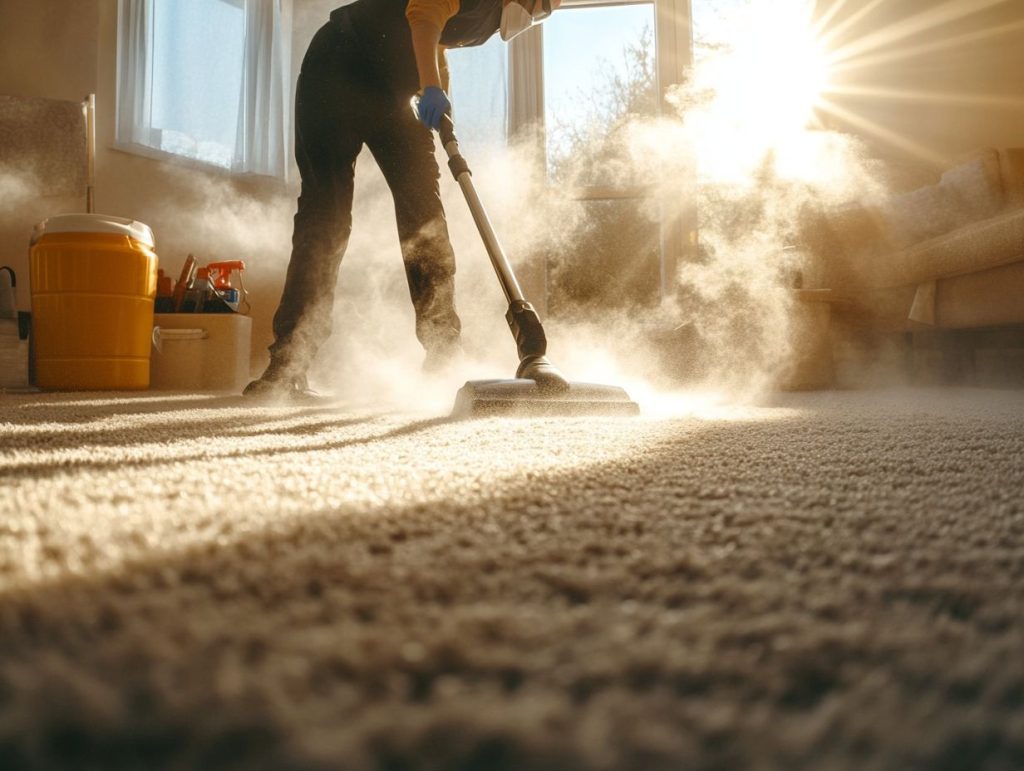Carpets are comfy, beautiful, and easy to maintain – the perfect addition to any home. Unfortunately, they are also the ideal breeding environment for mould and other types of fungi that often cause serious respiratory problems. The very nature of carpets – all the characteristics that make them arguably the most preferred floor-cover option – also helps mould thrive if unattended properly and immediately.
This article explores common respiratory problems like allergies and asthma and effective cleaning methods that can prevent mould. Discover practical tips for keeping your carpets and indoor environment fresh and safe.

The Correlation Between Carpets and Mould
Carpets can be a sneaky hiding spot for mould, especially in humid conditions, leading to serious health risks. It’s a concerning situation because carpets tend to trap moisture, creating the ideal breeding ground for mould spores to grow and multiply.
When air circulation is compromised, allergens and irritants can become even worse, ultimately impacting the home environment and indoor air quality.
How Mould Grows in Carpets
Mould growth in carpets occurs when moisture seeps into the fibres, creating a cosy spot for mildew and spores to thrive. Whenever your carpets get damp—thanks to spills or high humidity—they can quickly become a playground for mould if you don’t keep an eye on them.
To tackle this, you must understand what conditions lead to these infestations. High humidity can exacerbate the situation, especially in areas with poor ventilation or where water leaks occur.
Regular cleaning is your best defence against mould. Simple things like thorough vacuuming and steam cleaning can make a real difference. Mould types, such as Aspergillus and Stachybotrys, thrive in these moist environments and pose serious health risks, including respiratory issues and allergic reactions.
It’s also beneficial to understand how mould interacts with different carpet materials. Synthetic fibres often resist mould better than natural ones, highlighting why choosing your carpets wisely and keeping them well-maintained is essential.
The Impact on Indoor Air Quality
The mould in your carpets can interfere with indoor air quality, adding to the pile of allergens and air pollutants that can affect your respiratory health. When those mould spores go airborne, they can exacerbate allergy symptoms and trigger respiratory issues, so keeping your home clean becomes extremely important.
If you’re sensitive to these allergens, you might sneeze, cough, and feel generally uncomfortable. Poor air quality, often exacerbated by mould, has been linked to chronic respiratory problems like asthma, especially in the more vulnerable.
To tackle these risks, improving air circulation in your home is essential. Use extractor fans, keep your windows open whenever you can, and ensure your heating, ventilation, and air conditioning system has regular check-ups and good air filters.
Maintaining high hygiene standards, such as routine cleaning and promptly addressing any leaks or damp patches, can significantly reduce mould growth and the health issues that come with it.

Common Respiratory Problems Associated with Mould
You should be aware that common respiratory problems linked to mould exposure include asthma, allergic reactions, and various respiratory issues that can impact people of all ages.
If mould is present in your carpets, it increases the likelihood of allergy symptoms and exacerbates existing respiratory conditions, leading to serious health concerns.
Allergies and Asthma
Allergies and asthma are two common respiratory issues that can worsen when exposed to mould spores lurking in carpets. If you are dealing with these conditions, you may notice your allergy symptoms flaring up, dampening your daily life and overall well-being.
Mould spores can trigger many symptoms, such as sneezing, coughing, itchy eyes, and even shortness of breath. This is especially difficult for vulnerable groups such as children, the elderly, and anyone with a weakened immune system. To tackle these risks, it is essential to implement some effective allergen control strategies at home.
Here are a few things you can do:
- Vacuum regularly with a HEPA filter.
- Choose mould-resistant carpet materials.
- Keep indoor humidity levels low.
Following these practices can significantly reduce mould growth. Prioritising these steps makes your living space more pleasant and improves your respiratory health, allowing you to enjoy a more comfortable and active lifestyle.
Respiratory Infections
Exposure to mould in carpets can interfere with your respiratory health, especially if you have a weakened immune system or pre-existing conditions. The irritants released by mould spores can make breathing harder and turn your home into a breeding ground for infections.
If you’re in a vulnerable group—like children, older people, or anyone with asthma or allergies—you must be extra cautious. The risks of severe complications from mould exposure are higher for you.
To tackle this, keeping your space well-ventilated and managing humidity levels is critical to minimising mould growth. Regularly cleaning your carpets and using dehumidifiers can significantly reduce moisture, a major factor in mould taking over.
Choosing hypoallergenic carpets and using vacuum cleaners with HEPA filters can help lower health risks even more. By prioritising carpet hygiene, you can create a safer indoor environment and protect yourself and your family from the harmful effects of mould exposure.

Preventing Mould Growth in Carpets
Preventing mould growth in your carpets means taking a proactive approach. Regular cleaning and keeping humidity levels in check are key.
Good carpet hygiene and effective home maintenance strategies can reduce the risk of mould infestations and keep indoor air quality fresh.
Regular Cleaning and Maintenance
Regular cleaning and maintenance of your carpets are crucial for preventing mould growth and keeping your living space hygienic. This means you’ll want to vacuum regularly, deep clean occasionally, and use the right cleaning products to effectively tackle dirt, dust mites, and allergens.
Setting up a structured cleaning schedule helps your carpets last longer and improves indoor air quality, which is great for your household’s overall health. You can use various cleaning methods, such as steam cleaning and eco-friendly options. Steam cleaning uses high temperatures to combat stubborn stains and bacteria, while chemical-free alternatives offer a gentler touch—perfect if you have children or pets around.
By making these practices a regular part of your routine, you’ll create a safer, cleaner living space that contributes to the well-being of everyone in your home.
Proper Ventilation and Humidity Control
Proper ventilation and humidity control are key to keeping mould at bay in your carpets. Ensuring good air circulation and lowering moisture levels sets the stage for a healthier indoor environment. Maintaining that balance helps keep carpets dry and limits the chances for mould spores to thrive.
Dehumidifiers are wise, especially in damp areas like cellars or bathrooms, where humidity levels can creep up. Regular airflow is also important, so keep those windows open when the weather is pleasant, and turn on the extractor fans in your kitchen and bathroom.
These small practices not only help your carpets stay dry but also improve the overall air quality in your home, making it a more comfortable and healthier place.
By focusing on ventilation and moisture management, you can create a space where your carpets and everyone living there can thrive while keeping mould at bay.
Effective Cleaning Methods for Mould Removal
Effective cleaning methods for mould removal are crucial for keeping your carpets healthy and preventing allergens from taking over your home.
Whether you tackle it with DIY solutions or call in the professionals, using the right cleaning techniques can enhance the cleanliness of your carpets.
DIY vs Professional Services
Regarding mould removal, you have options—both DIY cleaning methods and professional services have pros and cons, depending on how severe the problem is and what type of carpets you have at home. DIY might save you money, but professional cleaning often delivers a more thorough mould eradication and better carpet care.
You may find yourself weighing the convenience of tackling mould problems independently against professionals’ expertise. For minor issues, readily available cleaning solutions can easily do the trick and keep your wallet happy, allowing you to feel in control of the cleaning process.
However, if you are dealing with a serious mould infestation that has penetrated your carpet fibres, calling the professionals can make a significant difference. They possess the knowledge and tools to handle the current issue and help prevent future outbreaks, creating a healthier living environment for you.
Ultimately, your choice will likely depend on your preference, budget, and the severity of the mould problem.
Non-Toxic Cleaning Solutions
Non-toxic cleaning solutions are becoming the preferred choice for mould removal. They provide an eco-friendly alternative that prioritises health and safety while effectively sanitising carpets. These solutions help you avoid the risks associated with chemical exposure during cleaning.
Using natural ingredients like vinegar, bicarbonate of soda, and essential oils, you can tackle stubborn mould while leaving your space smelling fantastic. Many households opt for these safe cleaning agents because they help reduce potential allergies and respiratory issues, making them ideal for families and pets.
Techniques such as steam cleaning, paired with these gentle solutions, can penetrate deep into carpet fibres, ensuring thorough disinfection without the unpleasant side effects of traditional chemicals. Moving towards eco-friendly practices protects indoor air quality and supports sustainable living by reducing your ecological footprint.
Other Tips for Maintaining a Healthy Indoor Environment
Maintaining a healthy indoor environment isn’t just about keeping your carpets clean; it’s really about taking a comprehensive approach to the health of your home.
This means tackling dust accumulation and improving air quality. By using some effective cleaning tips, you can enhance your living space and promote your overall well-being.
Reducing Clutter and Dust
Reducing clutter and dust in your home is key to keeping things hygienic, which supports your respiratory health and reduces allergens. A clutter-free space makes cleaning easy and helps minimise dust build-up that can trigger allergy symptoms.
You can incorporate practical strategies, such as stylish storage solutions, to enhance your space’s appearance and functionality. Creating designated spots for the items you use frequently streamlines your daily routines and keeps the mess at bay.
Establishing a solid cleaning routine—perhaps dedicating specific days for dusting and vacuuming—will help ensure that dust doesn’t get a chance to settle. Over time, these habits will create a healthier home environment, leading to better indoor air quality, less stress, and overall well-being for everyone living there.
Regularly Changing Air Filters
Regularly changing your air filters is a game changer for maintaining good air quality and reducing allergens in your home. Clean air filters enhance ventilation and help keep dust and mould spores at bay, making your indoor space healthier.
Establishing a consistent cleaning schedule for those filters means they will operate at peak efficiency. This not only improves your air quality but also extends the lifespan of your HVAC system. You have options, too—such as HEPA filters that capture even the tiniest particles or carbon filters that effectively tackle odours.
By understanding the different types of filters and what they do, you can make informed choices that significantly reduce allergens and create a cosier living space. This proactive approach leads to better respiratory health and an overall improved sense of well-being.